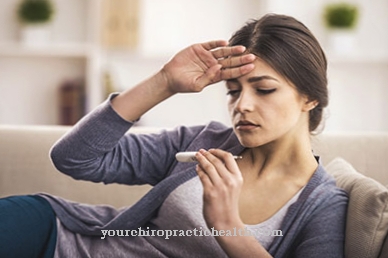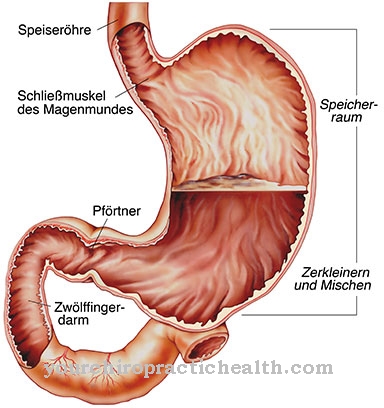Under a Equinus one understands an either congenital or acquired in the course of life misalignment in the foot, in which the heel is raised, which leads to problems in the gait pattern and on the skeleton.
What is an equinus?

© oliverfroehlich - stock.adobe.com
At the Equinus the heel is raised so that only the ball of the foot touches the ground when walking. The equinus is in a permanent flexion position, which cannot be corrected passively.
The equinus is also known as pes equinus (horse's foot), as almost all quadrupeds appear with the ball of the foot or toe area. In humans, however, the equinus is not physiological, as the body weight only rests on the forefoot and a stable stance cannot be guaranteed.
There is also uncertainty in the aisle due to the non-existing rolling process.
causes
The causes for one Equinus can be very different. First of all, a distinction can be made between congenital and acquired equinus.
In the congenital equinus, for example, there is an underdevelopment of the lower leg or a poor posture in the womb. In this case, the equinus is also referred to as a club foot. The equinus does not usually develop until after birth, for example due to polio, a disorder of the nervous system, after an injury to the ankle (which has led to a shortened Achilles tendon) or due to mechanical causes such as long bed rest.
In most cases, however, the nerve function is impaired, so that the calf muscles are shortened or the nerves are paralyzed. Habitual equinus foot occurs when children walk too often on their toes when they are learning to walk.
Symptoms, ailments & signs
The raised heel of an equinus is usually visible to the naked eye. Affected children walk mostly or entirely on tiptoe and cannot roll the foot from the heel. The calf muscles may appear noticeably shortened and it is not possible to press your heel on the floor while standing.
The equinus is often seen in bedridden people. Just by the pressure of the duvet on the toes and forefoot, the foot is brought more and more into flexion. After a while, those affected can no longer actively bring the foot into a 90 ° angle to the lower leg. The calf muscles and the Achilles tendon are noticeably shortened.
The symptoms are mainly evident when walking and standing. Depending on the severity of the equinus foot, those affected only walk tiptoe or can no longer walk due to the malformation.
Calluses on the ball of the foot are also a clear sign of equinus, as the entire body weight rests on this small area. If the equinus foot has existed for a longer period of time, the changed gait may result in a curvature in the spine.
Diagnosis & course
The diagnosis falls in one Equinus not very difficult, as the misalignment is very noticeable even for a layperson. The gait is also examined by the doctor during the examination, as is the passive movement of the foot.
In order to find the exact cause, however, diagnostic tools such as x-rays, electromyography or muscle biopsies (removal of tissue) are required.Not only the foot, but also the other joints of the lower extremities and the spine are examined to determine the effects of an equinus foot.
The course of the equinus depends on the cause, for example, the habitual equinus still has a good prognosis in childhood, it often regresses itself with growth. In other equinus species, however, the course is somewhat more extensive and longer; usually it cannot be completely reversed. The result is problems in the knees, pelvis and spine.
Complications
The changed gait pattern in equinus foot can lead to further misalignments. In the long term, this can lead to joint wear, arthritic diseases and other complications of the bones and joints. Often visible calluses form on the feet due to the unusual gait. These are usually associated with severe pain and a feeling of pressure and can rarely develop into abscesses or serious inflammation.
In the long term, the high stress on the knee joint causes arthritic joint changes. In children, the spine can curve in the lumbar region and the hips can shift. This creates a functional malposition. This is often accompanied by chronic pain. In the long term, these stress the person affected psychologically and can trigger depression, for example.
Surgery can be associated with nerve damage, bleeding, and inflammation. After the operation, wound healing disorders, secondary bleeding and excessive scarring can occur. The use of painkillers can cause side effects, interactions and allergic reactions in some people affected. If used incorrectly, orthopedic aids can also cause complications, which in many cases exacerbate the underlying condition.
When should you go to the doctor?
A doctor should be consulted as soon as there are irregularities in locomotion. If it can be observed in children or adults that people only walk on tiptoe, clarification of the cause is advisable. Normally, the foot is put down with the heel while moving and then the foot is rolled over the heel to the toes. This is a natural movement. If there is a different sequence of walking or running, this should be discussed with a doctor. Permanent impairments of the skeletal system can arise which should be prevented.
If muscle complaints, pain or misalignments occur, an examination and a treatment plan should be drawn up. If the spine is curved or the gait pattern has changed altogether, the person concerned needs medical help. If locomotion is difficult, if it costs the person concerned a lot of strength or if fatigue occurs quickly, the observations should be discussed with a doctor.
If sporting activities cannot be carried out as usual due to the symptoms, a doctor's visit is necessary. A decrease in physical resilience or psychological problems are also reasons for which cause research should be carried out. If there are joint problems, swelling of the feet or an uncomfortable feeling of pressure on the calves, action is required.
Treatment & Therapy
Treatment for one Equinus also depends on the cause and especially the severity. If there is no shortening of the calf muscles, simple but consistent active movements can reduce the equinus foot.
This is done through physical therapy. Often patients are given a lower leg standing cast, which stabilizes the foot and is supposed to bring the foot back into its normal position over several weeks. Surgery is rarely performed on equinus, only if the Achilles tendon has to be lengthened due to excessive shortening.
This operation is particularly successful in children; In adults, in the worst case, a joint stiffening of the upper ankle joint is carried out when the cartilage is already severely worn. In addition, the equinus can be treated with orthopedic shoes.
prevention
One Equinus can definitely be actively prevented. Even if you are confined to bed for a long time, for example, the foot can be fixed in the normal position by sufficiently positioning it at the foot end.
Physiotherapy is necessary to stretch the shortened muscles, both actively and passively. Except in the case of an Achilles tendon tear, it is important that if the foot is injured it is also fixed in the neutral position so that an equinus foot can be avoided.
After a rupture of the Achilles tendon, the right physical therapy is particularly important in order to bring the foot back into the correct position and not get a permanent equinus. The most important component here is stretching the calf muscles.
Aftercare
After the treatment of an equinus foot, comprehensive follow-up care by a specialist is necessary, especially after an operation or lengthy physiotherapy. Follow-up care includes a physical exam and a conversation with the patient. As part of the physical examination, the orthopedic surgeon checks that the foot is healing properly.
If necessary, an X-ray or another imaging procedure will be used to precisely determine the health of the affected foot. After an operation, it is important to check the surgical wounds. The prescribed pain relievers and anti-inflammatory drugs may also have to be reset. Various drugs must be slowly tapered off.
This should be monitored by the family doctor in order to minimize the side effects as much as possible. The equinus foot follow-up is usually carried out by the orthopedic surgeon who was already responsible for treating the malformation. If complications persist, other doctors can be involved in treatment.
If no complications or other abnormalities are noticed, the treatment is concluded. The patient should consult the orthopedic surgeon once every six months to ensure that the equinus does not return and that no other discomfort occurs. In the event of pain in the feet or other problems, the responsible doctor should be informed.
You can do that yourself
To avoid accidents or other complications, feet and movements should be exercised daily. Especially if you are bedridden, it is particularly important to tense your muscles and perform movements. Everyone can do this independently, you don't need any instructions or specifications. The joint activity is also to be used daily so that impairments and disturbances can be avoided.
It is particularly important to pay attention to the requirements of the organism when moving. Avoid hectic movements. In addition, you should refrain from subjecting the body to excessive physical stress. If locomotion is impaired after illness, a fall or an accident, particular caution is advised during the healing process. Excessive demands can lead to secondary diseases.
If a physiotherapeutic treatment takes place, the techniques and training learned there can also be carried out independently outside of the sessions. In addition, the right footwear should be worn. High heels are not recommended and shoes should be the size of the foot. Otherwise the risk of accidents while moving increases. In order not to build up any additional stress on the organism, obesity should be avoided. This has a very strong effect on the feet and leads to pain. As soon as the person concerned notices problems with locomotion, he should take breaks in good time.



.jpg)









.jpg)

.jpg)
.jpg)











.jpg)